Second Season: Episode #13
A Feeling of Warmth
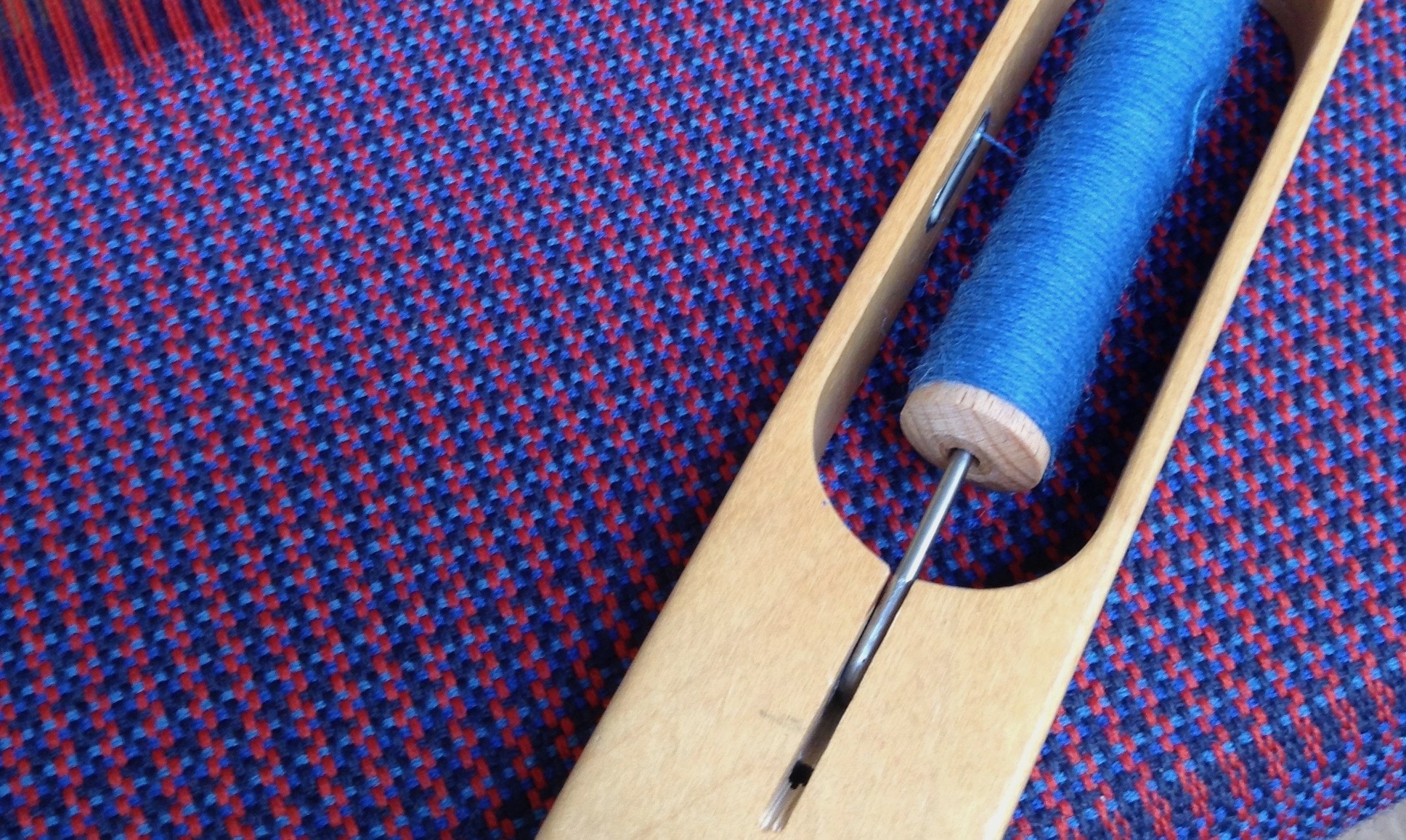
A Feeling of Warmth looks at the alchemy of giving wool a purpose in the age of man-made fibres and diverting it from being dumped or burnt. It hears about the skills and care needed from the shepherd, the shearer, the spinner, the weaver and the tailor before we can put a wool garment, made sustainably and ethically, on our backs.
Great thanks to Maria Benjamin and John Atkinson, farmers and entrepreneurs, Lara Pollard Jones of the spinners, World of Wool, Sam Goates, weaver of Woven in the Bone, the tailor, Karyna Sukha from Fabrika, the designer/maker Sally Cowell, from Leven Knit and Sew, and to Donald S Murray for permission to read his poem, Woven in the Bone.
If you want to see more about the jackets and shepherd’s bags that are the subject of this podcast or find out more about John and Maria’s work at Nibthwaite Grange Farm, including the knitting yarn, the fabric, the soap, the meat, or the holiday accommodation then the links are https://dodgsonwood.co.uk/about/ and https://nibthwaitegrangefarm.com/about/ You can see the full drama of this year’s lambing on Maria’s Instagram at https://www.instagram.com/dodgson_wood/
World of Wool can be found at www.worldofwool.co.uk
Sam Goates and Woven in the Bone are at http://www.woveninthebone.com/ or https://www.instagram.com/woveninthebone/ Inspiration for Maria’s jacket came from a friend of Sam’s, Dorothy Williams, who made Sam a special Weaver’s Jacket on which the Herdwick jacket was loosely based. You can see a picture of Dorothy’s Weaver’s Jacket below.
Karyna Sukha, whose London tailoring shop makes the jackets are at https://fabrika.london
Sally Cowell of Leven Knit and Sew – who makes the shepherd’s bags can be found on Instagram at https://www.instagram.com/levenknitandsew/
And the poet Donald S Murray can be found at http://www.donaldsmurray.co.uk/ Sadly, his book of poems, Weaving Songs, is out of print, but if you look on Book Finder you can probably find a second-hand copy.
To sign up for your own link to the Haptic and Hue podcasts as they are released, for extra information and a chance to access the free textile gifts we offer with each podcast in this series, then please fill out the very brief form here. If you are interested in a long read or two or want to know why and how cloth speaks to us then you can find articles at www.hapticandhue.com/read
You can follow Haptic and Hue on Instagram @hapticandhue on Facebook or Linked In under the Haptic and Hue name.
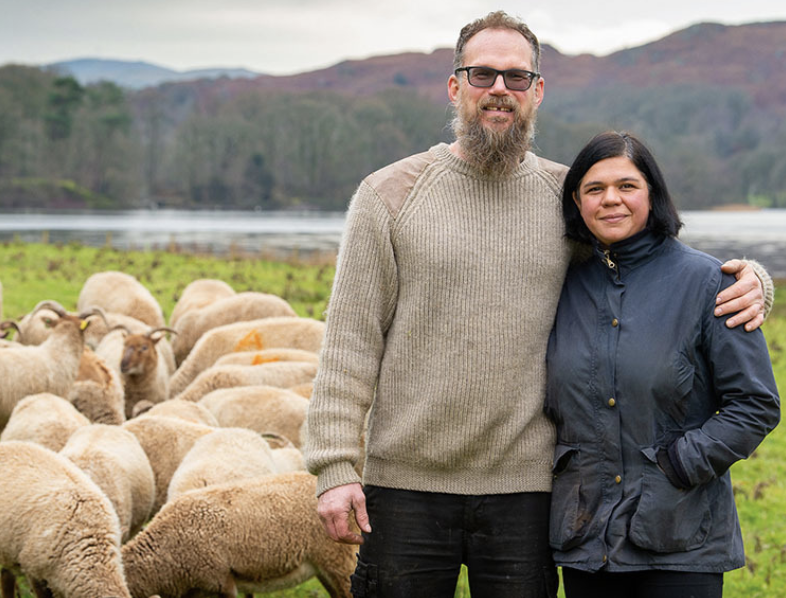
John Atkinson and Maria Benjamin

Part of Nibthwaite Grange Farm

Nibthwaite Grange Sheep

Castle Milk Moorit Lambs
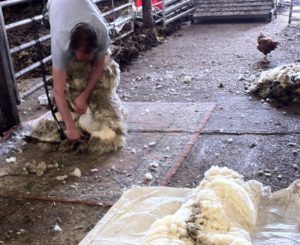
Shearing at Nibthwaite Grange
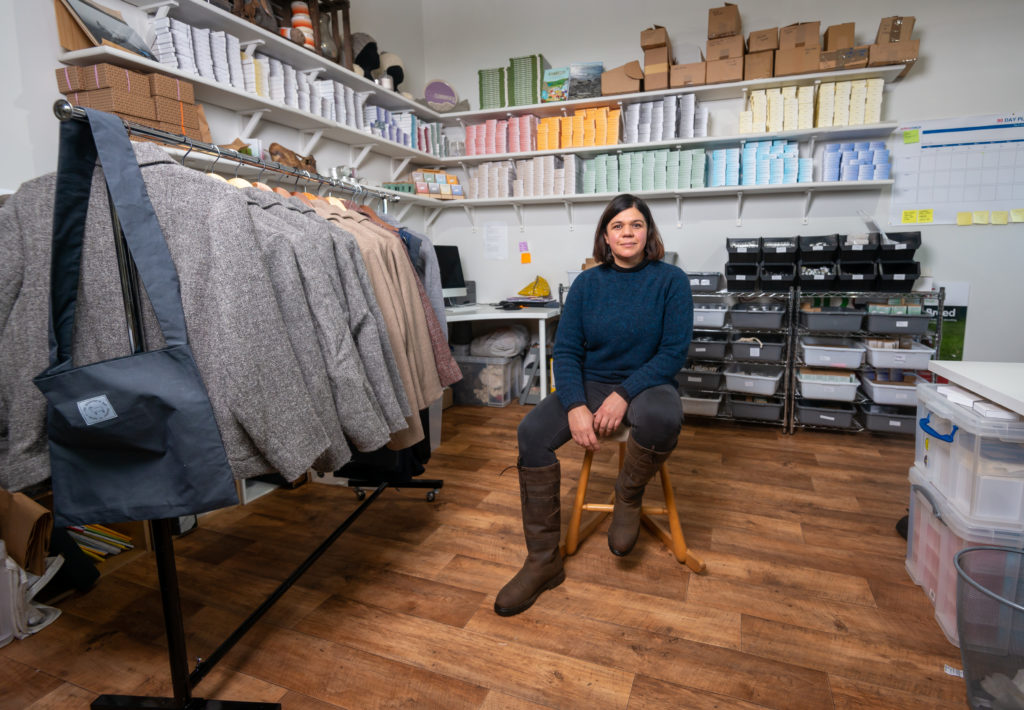
Maria in the shop

Finished Shepherd’s Bags
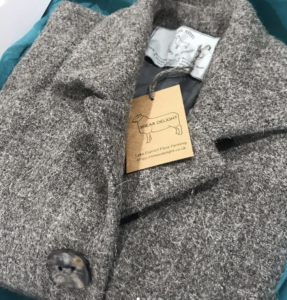
Herdwick Wool Jackets
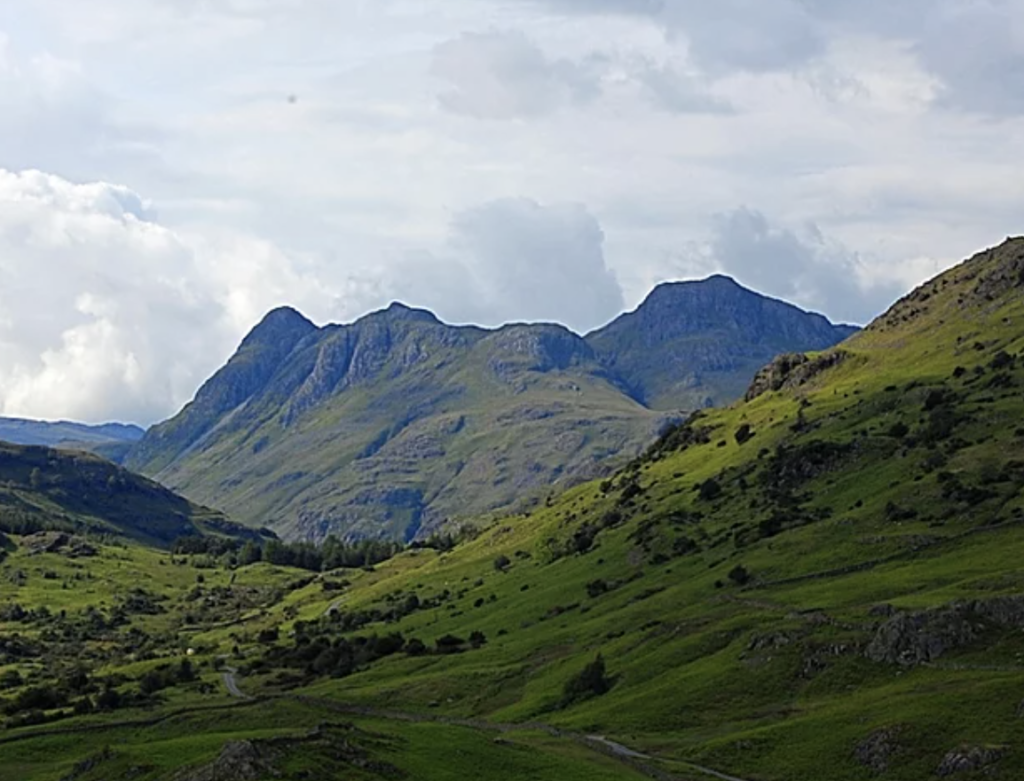
Great view!
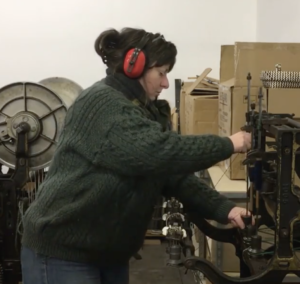
Sam Goates at Work
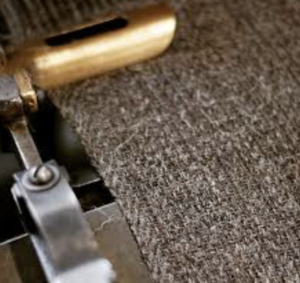
Cloth on the Loom
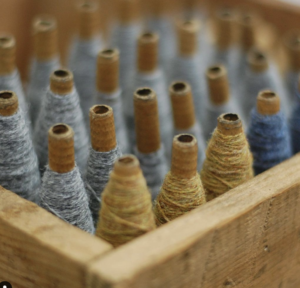
Spun wool on pirns
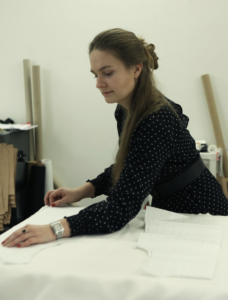
Karyna at Fabrika
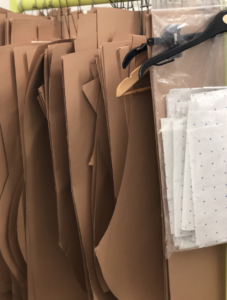
Pattern Making
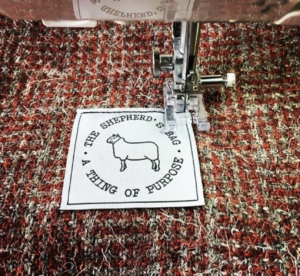
Sewing in labels
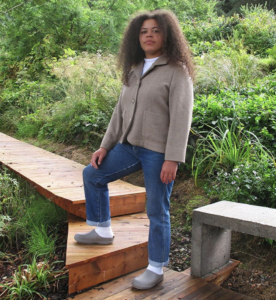
The Finished Jacket
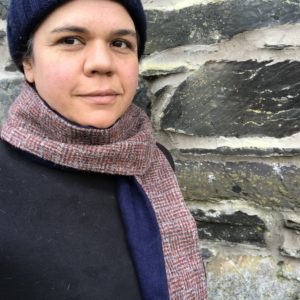
Maria in one of the Herdwick Scarves
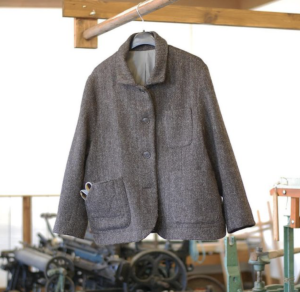
The original Weaver’s Jacket by Dorothy
Williams
A Feeling of Warmth – Script
All over Britain’s sheep country at this time of year, you can hear sighs of relief and the sound of farmers, briefly, putting their feet up, or at least getting to bed at night. From the highlands of Scotland, the mountains of Wales, and England’s fell country to the marshlands of Kent and the chalk downs of Dorset, Lambing is finished for this year. For better or for worse, it is done.
Oh gosh, it’s a bit like a horror version of Call the Midwife, it’s extreme drama you never quite know what you’re going to come across in the lambing shed. And sometimes it’s a beautiful scene with lamb curled up with its mum. And sometimes the trauma of birthing the lamb means that she hates her lamb and won’t accept it. And each lamb that’s born and its mum, they have their own unique story. Sometimes when you see them from a distance and a field seems quite generic but isn’t it, they’ve all got their individual stories.
The lows are when you think you’ve done something wrong. So you think, Oh, well, I could have saved that lamb or if it’s an absolutely terrible day that you know, lambs two to three days old, start dying because of hypothermia, and they just can’t take the weather. You think, Oh, I wish I had a great big shed and I could put them all inside and look after them. And when it’s a beautiful sunny day, everything’s going all right, and you’re walking around and there’s nothing to do. And the sunshine in, it couldn’t be any better.
Welcome to the second series of Haptic and Hue’s Tales of Textiles. I’m Jo Andrews, a handweaver interested in how all kinds of cloth speaks to us and the impact it has on our lives.
Each of the episodes in this series takes an emotion and unravels how we express that in textiles. This episode is a feeling of warmth – a universal human need since the beginning of time and in the chilly zones of planet earth, there is one animal that has played an incredible role in stopping us freezing to death.
Sheep have been humanity’s great companions since farming was invented, they have supplied us with meat, manure, milk, horn, and most of all wool. In this episode, I want to unravel the journey that fleece takes from the back of a sheep to the back of mankind. How does a handful of greasy wool, bred in the wind and rain of a high farm, become a smartly tailored jacket, a beautifully knitted pullover, or a lace weight shawl fine enough to pull through a wedding ring? Too often we don’t know who makes our clothes or what the conditions are in which our knitting yarn is created. This episode is about what real sustainability and integrity in the entire journey from fleece to fashion garment looks like and the skills and jobs it conserves.
If you rang up Hollywood casting and asked for a perfect British Farm to star in a movie, then Nibthwaite Grange in England’s Lake District would have a good chance of getting the part. Built of local stone, it sits high above the southern end of Coniston Water surrounded by the hills. John Atkinson’s family have been there some time:
Yeah. So I’m the sixth generation from here and then my family’s lived in the valley, well, I would say since God were a lad, at least as far back as the records go, We moved three miles in that time. So there’s always been an Atkinson farming in the valley. I’ve got relations all over the world but there’s always somebody stopped in the valley basically.
But modern-day farming in this tough landscape has barely delivered a living for John, who for many years had a full-time job alongside the farming. But for him it’s always been about more than just the finances:
So, you are always trying to improve on the stock. And so you’ll see a calf born and think that’s a cracker or a cheap lamb born and I’m watching it grow up and mature and hopefully, it’s, you know, it grows into something superb. So farmers are always very proud to produce something looks really good as well as being functional and valuable.
Over the centuries Atkinsons have been farmers, methods and values have changed. Once sheep were cherished above all for their skins: our earliest records were written on parchment, by the light of a tallow candle made of sheep fat. And then it was for wool, which for centuries was the bedrock of Britain’s wealth, but today its meat which is by far the most valuable part of a sheep. Wool has become almost disregarded, supplanted by man-made fabrics and cottons. Farmers get pennies from the British Wool Board for shearing their sheep, and many do it now just as a kindness to the flock and then burn the fleece rather than have the bother of dealing with it. But John and his partner Maria Benjamin wanted to change that.
Well, so I don’t come from a farming background. I joined John and the farm about five years ago, maybe six, now. And I come from an art background and I worked for quite a few years for Grizedale arts. And I think that gives you a different way of looking at things, looking at things as opportunities or so problem-solving meant that when I saw the wool and finding out that it was just kind of worthless, I just thought it was crazy. ‘Cause I know historically that it wasn’t worthless, much of our economy was based on the wool trade. So I had no idea that as farmers got so little for it, so it was just something that was playing on my mind, you know, what can we do to make worth something. So that we made the most out of what we had on the farm. What can we do that we, that in improve the kind of income of the farm, really with what we hold at the house? But I had no experience. I didn’t know how to knit. I still don’t really know how to knit. But, as an artist, what you do when you don’t know something, you just do tons of research and you just learn, once you get a bee in your bonnet, you don’t really give up till you find a solution.
Maria is a woman of great determination. Her solution to the wool problem began with knitting – never underestimate the power of knitting:
So I just had a very small batch done just to see, I wasn’t investing too much money just to see what we could produce. And that’s where it started really. And it was quite exciting to get these beautiful bowls of wool back that looked like, you know, they were from a shop. I just started selling them. I try to crochet a few hats for myself and for John and yeah, just from there. So very slowly I just built it up, then I had a stand at WoolFest as well, so I could sell some of my wool there. And that was good talking to people finding out what customers wanted because there are so many people that are wool connoisseurs desperate for single farm yarn with provenance and breed-specific wool actually. And that was really interesting. So it’s a smallish market, but it’s a market that has money to spend on wool and real enthusiasts. So that was, that was really quite exciting.
Britain is in many ways the home of sheep, it doesn’t have the largest flock – that honour belongs to Australia with 65 million sheep. But the UK has more than 60 native breeds and British breeders have had a hand in developing many of the sheep that populate the pampas of Argentina, the plains of Australia, and the green lands of New Zealand. So if you are looking for provenance or single breed wool, Britain is a good place to start.
Maria had knitting wool made with fleece from her, Cheviots, Teeswaters, Castle Milk Moorit’s and Blue Leicesters, it sold well, and then she had a conversation with her neighbour, James Rebanks, best-selling author of The Shepherd’s Life and well-known farmer of Herdwick Sheep who are sheep with tremendous character and an ancient history.
After reading James Rebanks’ book I met him at I think it was the Westmoreland Show. And there was, I think it was just telling him well, you should do something with your wool. You know, it’s, it’s crazy to get so little from the Wool Board. And I was sure that he could sell it for a premium because he’s such a well-respected farmer and writer. And he said, well, why don’t you take it and make something with it and then just pay me when you’ve made some money for, but yeah, it was really nice that he trusted me with it, but that was great, but it was also quite daunting because obviously, I felt like now I’ve got to come up with something and do something good with it and actually make some money. And there’s a lot of wool, where am I going to store it? It was a bit of a nightmare to think through what to do with it because I just really, I just didn’t know if it could make nice knitting wool or what I could do,
This was a real challenge: Herdwicks are wonderful beasts, hefted to their land, but their wool is tough stuff, it’s not something you want next to your skin, it’s prickly stuff. So what could she make from this wool in a world that prizes soft and cuddly? This is where Maria has proved herself a modern-day alchemist, transforming something nearly worthless into gold. Her idea was to make Shepherds Bags and Tweed for lined jackets from James Rebanks’ Herdwick clip. But she had to get the fleece from fell to finished product and that’s a story in itself, one of skill, care, and originality. First stop Huddersfield about a hundred miles from the Lake District.
My name’s Lara, Lara Pollard Jones and I do customer relations for World of Wool. World of Wool is an interesting business it’s based in Huddersfield in Yorkshire. And it specializes in all sorts of wool, everything from British wools to Merinos. And you name it, we’ve stocked it at some point.
World of Wool is a family business that specialises in individual orders. Lara says every batch they do is their most important job:
Okay. So Maria’s wool will get dropped off to us. And from the moment it arrives, we start working with it. So the first thing that we do is check the weights that come in because of the size of our machinery, we need to make sure we’ve got usually roundabout 200 kilos of raw wool per batch that we do. When you process the wool, especially wool like Maria’s, you do get quite a bit of loss and that’s through grease and slightly more coarse fibres. And so we need to make sure that what is being spun is roundabout 100 kilos. So once her 200 kilos lot comes in, we’ll weigh it up, and then we’ll get it scoured, which is the washing process. This removes any grease, mud, dirt, anything that the sheep and the fleeces may have picked up while they’ve been out and about on the hillside. And from there you’ve got clean fibre, that’s ready to go. Next, we card it and prepare it for spinning. Now some of Maria’s yarns are spun for weaving and some are spun for knitting. When it comes to weaving, we need to make sure the yarn’s got a nice high twist to it so that it will be strong enough to be run through the looms. So we clean the fibre and we pop it onto our spinning frames and then start spinning it to a certain specification. Now, every Weaver likes to work with something different and the specification used also depends on the final garment or use of the yarn. So if Maria said, right, we want to make a suit out of this, we would then spin a very, very fine yarn. If she said, I want to make a rug out of this, we would spin a very thick and heavy yarn. So this also affects the durability Maria’s fibre is spun to be a quality that makes a nice lightweight cloth once it’s woven.
World of Wool has had a tough time during the pandemic but they have managed to keep working throughout and no one has been laid off. And the good news is that there is increasing demand for their service– there are more and more single provenance small flock fleeces coming to them.
Well, I think people are starting to realize the importance of natural fibres and also the sustainability of things. And there is nothing wrong with man-made fibres. They have seen us through for many years and they will continue to do so. And they are also very, very practical, but there is something about wool, which is so important, and it’s such a versatile and such a good all-round fibre as well. If you consider the life of the sheep, what the sheep does, how it gives back the land as it’s eating, as it grazes the fields, the fleece’s carbon sequester, and the garments that are made from pure wool or even blended wool items are very, very durable. For example, fishermen’s, ‘gansies, they’ve been made from pure wool for years and years and years, and they’ve even been in the past treated with lanolin to help the longevity of it. And many people will remember a wool blanket that their grandmother had, or they will have a specific pair of wool socks that have lasted forever. So the durability, the long-lasting nature of the products are really important and smallholders and farmers are beginning to see that actually, what has previously been a by-product of the sheep – obviously not many, many years ago, but more recently – can be used to generate a really good income for their farms and their holdings.
Now washed and spun Maria’s wool sets on its way about 400 miles north of Huddersfield to Buckie – a fishing village on the Moray Firth. There the yarn is dropped at a small shed that overlooks the harbour, from where on most days, you will hear the distinctive music of old Hattersley foot looms
Oh, I’m just so lucky. It is just the nicest place to work. And then, of course, you get to see the sea every day. So, it’s a great place to be. And the reason I’m here basically was finding a place that was suitable for my looms. I thought the fact that I live relatively rurally, I thought there would be heaps of, you know, sheds to rent with all the farm buildings around and countryside and all sorts, but actually it took me months to find somewhere because it had to be watertight, weatherproof, mouse-proof for the yarn, flat, good flat floor and cheap! And in the end, I had to put an ad in the paper ‘cause I couldn’t find anything. And a lovely, lovely couple who happened to have this yard down at the Harbour that’s been in the family since the late 18 hundreds. And there were those two big, sheds, they store all their tools and stuff in one and the other one was, was half empty. So I’ve managed to rent that and it’s just been the best thing ever.
Sam Goates set up Woven in the Bone eight years ago as a bespoke weaving business.
So yes, it pays the bills, that’s its main job. My background’s all in commercial design, so I suppose it was all about, you know, what can I do with all the skills that I’ve collected all my life. And part of that I suppose, has always been in the design and product development. In the back of my mind, I’ve been collecting ideas on, you know, what could I do, what niches are there, what could I do that somebody else isn’t doing already, because that’s always better. And it kind of came out of that really.
Sam started life as a handweaver and then worked in commercial mills. She discovered the old Hattersley Looms on a consultancy job in the Outer Hebrides where they are the mainstay of the Harris Tweed industry and she decided to combine her craft skills and her commercial experience and create a special kind of niche business, one that’s travelling as far as possible away from a world of international fashion with huge runs of garments that look exactly the same.
If you go into any of the tailors, they will have, you know, maybe 10,000 different cloths that will come from having a number of large makers or cloth merchants that have been around for many, many years, but those cloth merchants are really big businesses. So the same cloth would be available in London as it would be an Inverness as it would be in Hong Kong or New York. You might have a unique jacket that was made exactly for you, but it’s less common for you to have a unique jacket in a unique cloth. Like any business, if you’re in a marketplace and you have competitors, but you all have to buy the same raw materials, it’s hard for you to stand out in the marketplace. So if you have an opportunity to have your own cloth that becomes almost a badge of your own brand, then that will be attractive to a certain part of your clientele.
Sam says Maria is an amazing entrepreneur. Maria called her out of the blue one day and explained that she had some wool that she wanted to do something with – could Sam help?
And we just immediately hit it off on the phone. She had a neighbour who had this wool and it turned out, of course, it’s James Rebanks. And so you know, she’s a smart cookie. James has written beautiful books, has a name and a following in his own right. So she wanted to try and do something creative with his wool. She’s got an arts background, so she’s, a creative visual person. She wanted to make something with it. Just didn’t know where to start. And that’s why she kind of stumbled on me. And I’d read James’s book. So I was like, Oh, well, I’d love to do something with his tweed. And so it kind of went from there and, she was lucky because she has volume. So she’s able to get volumes of quantities spun. Originally I’d said to her, look, you know, the quantities you’re going to have would be way too big for me, but if you want to use me to start with you know, we could do it as our sort of product development run, and you can test the market what you want to make with them. And you know, if that goes really well and you want to go bigger well, you know, I understand. But actually, she came back to me after the first run and said, I’d rather stay with you. So that was really, really lovely because, you know, she could have made it a lot cheaper. But you know, , I suppose we’ve built up a bit of a relationship and now she’s making jackets and she’ll be looking for other products to make out of it, I’m sure. So it’s worked, it’s turned into a really nice, really nice line. She does great things and she’s, she’s such an interesting person. So yeah, we have, we have a good laugh when she rings.
Sam works with her customers to make sure they get exactly the design and look they want. She weaves in different fibres and qualities, herringbone, estate cloth, Donegal tweeds, Scottish Merino, Moorit Wools. She has roped 2 of her 3 sisters into the process as well and on a good day, the clickety-clack of the old looms tells you that artisan cloth is being woven in the shed. But Sam knows that times are incredibly tough for wool producers.
I love to do it because it is British wool and I know the British wool industry has had incredible challenges. So that’s driven by market demand. You know, looking back 50 years ago, everybody woretTweed. Everybody wore wool. And I think it’s around the 1970s when, whenever polyester was invented. And then suddenly, people were wearing polyester outerwear. So tweeds and things became, you know, sidelined or unfashionable.
But she does see a future for British wool
I wear it every day. I work with it every day. So for me, it’s, it’s absolutely a massive part of my life. And I can’t imagine that changing because it has all the performance characteristics it’s warm, it’s comfy, it’s breathable, it’s natural, there’s just nothing bad about it in my book. And so to choose another fibre over that I find that quite hard. So I see a future for it, but I totally understand that there are challenges to the industry. And some of that is about perceptions. Some of it’s about market changing. I mean, the consumer has to value things differently daily to the way that we have become used to valuing or not valuing things.
Sam sends Maria’s cloth to be professionally finished, And then fabric sets off for its trip to London to be turned into a thing of beauty:
Hi, my name is Karina Sukha. I am an owner of Fabrica, which is a London sampling studio slash garment manufacturer.
Karyna set up Fabrika because she was working in the clothing industry and she was having trouble finding someone to produce small runs or samples. Fabrika works directly with clients to translate their creative ideas into beautifully made garments.
At the moment we have a team of six people. We have the greatest seamstresses and cutters possible. I’m very happy with my team. They always support me. They work to the best quality. They’ve all been working as seamstresses and cutters for over 20 years in London, as well as in their own countries. ‘Cause most of them are international. So we have a strong team and we try to deliver the best possible sewing and pattern cutting we can.
Karyna’s team turns out runs of anything from 1 garment to about 150. They work with high fashion brands and farm producers, she says that involves every kind of material – except leather, which needs different skills. Everything is made up in Fabrika’s workshop in East London, nothing is sent out to be done by others.
We are making jackets for Maria. They’re made out of local locally made tweed fabric as well as cotton for the lining. And she always sends us beautiful horn buttons, which we attach to these jackets. We have developed this together with her. She sent us an example of what she wants to do and we made the whole range starting from pattern then sample and then a small production run.
Maria orders about 10 jackets at a time, which is a really small run, and most people wouldn’t be happy to do it. But Karyna says the seamstresses love Maria’s cloth:
So it can be a bit more time-consuming to work with this sort of material, we need to make sure all the seams are securely finished as well as in some cases working with French seams,
for example, this type of seam. We need to give a bit wider seam allowance to make sure that the seams are stronger and the garment will be worn for longer. Also depending on a fabric, it is always a good idea to change needles regularly to make sure it’s sharp. it is always amazing to experience new things. It’s not very often in our industry that you can get locally made material. It is, yeah, it is beautiful material. And even though it is tricky at the beginning after you get used to the material, it’s actually a very pleasant job.
What Karyna offers apart from the very small runs and the personal service is much greater flexibility and transparency.
We can always readjust the orders in case anything changes. We’re very flexible because we’re so small. We can make changes if something goes wrong, we can always invite the designers to come and see how the collection is doing. So this is where I value the personal connection and I find that in some bigger manufacturers, it’s just harder to keep that flow also, it is great to make things locally and to be able to see how they’re made. I think this area will be developing, especially now when a lot of companies would be trying to make things locally due to difficulties in transporting to Europe and internationally.
As a finished garment, the Herdwick Jackets travel back to where they first began, Nibthwaite Grange Farm to be re-joined by The Shepherds Bags which are made up by hand much closer to home, by Sally Cowell at Leven Knit and Sew in the Lake District itself. Maria dispatches them all over the world from Nibthwaite to people who care about them and like the story behind them.
The people that buy from us, that’s why they’re buying from us. It’s because they love that whole process, the whole process is very transparent from start to finish. I think people really appreciate that they like the backstory, they like the provenance of the wool. That’s, why they support us, you know, otherwise, they would just be going to TK Max to get something on the cheap, you know, so I really appreciate the people that are our customers, I guess we provide people with what they’re looking for in life, which is more sustainable living.
This isn’t a hobby, Maria’s diversification into yarn, cloth, soap, and holiday accommodation has doubled the farm’s income, making it possible for Maria and John to have one job each – being on the farm:
It’s only quite recently that there’s that business model of well farming has become like a business model that, that model of this weird sort of efficiency by just streamlining everything, like that progress. And it isn’t really because it makes a farmer very vulnerable by just doing one thing. And from the outside that can, you know, it looks like all streamlined and efficient, but it isn’t, it really is quite fragile. And I think our way of working, which is we can adapt, it’s like nature really nature is incredibly complex and diverse and it’s adaptable. So when conditions change, it means that the whole system doesn’t break down. If you’ve just got a monocrop and something happens, you’ve lost your whole crop. Whereas if you’ve got a diverse landscape, some things will survive and other things will die back for a while, but it will probably come back at a different time, our business is like that. So obviously during lockdown, the accommodation was empty, but because we have these other income strands that supported that, that meant we were still a viable business.
And more than that Maria’s work and determination means that the enormous loss inherent in burning or dumping a fleece is avoided.
There’s so many losses. It’s not just the loss of the wool. When I think about the process of the wool to the finished product, there’s at least seven businesses that benefit from that process of doing something with the wool. So if you just burn it, all that potential energy is just gone and, it’s gone into the soil, so it does something, but if you do something with it, so you’re paying shearers, you’re paying the farmer for the wool, you’re transporting the wool, so you’re paying a haulier, you’re paying the spinning mill. We pay the Weaver, we pay the person making the bags. We have staff here that work for us to send out the products when people are online. So that’s seven, and then obviously the person that makes the jackets as well. So that’s another person that makes it up for us. That’s eight, those are other businesses that benefit from us making that decision, not to burn the wool and to try to do something with it. And there’s definitely far more profit than if we burn it or, even if we just sold it to the Wool Board. So there is a bit of work, but I think the work is so beneficial, not just to our business, but to other businesses. So I’m, I’m happy to do it, and I’m happy to provide a beautiful product to our customers as well.
It’s wonderful that the small businesses exist that allow Maria’s wool to complete its journey sustainability and transparently, without air miles, but the chain of skills and enterprise that allow this to happen is a fragile one, and every one of us has a role in deciding whether it lives or dies in the decision we make about what to wear or what to buy. For Maria it’s a huge thrill to wear your own cloth and to see others do that too:
Yeah, it’s like I guess it’s the same as when we eat our own meat. It’s so close to you. I think it feels so right, but actually, I get more excited when I see other people wearing our cloth someone buying some cloth from us and making a skirt or jacket, or, you know, someone posting a picture of them with the bag and that feels really, really exciting.
Thanks to Maria and John the farmers, Lara the spinner and dyer, Sam the cloth designer and weaver, and Karyna, the tailor for sharing their thoughts about the processes they are involved in.
If you’d like to look at pictures of their work or see links to their work and the books I found useful in putting this episode together then please go to the page at www.hapticandhue.com/listen, where you will also find a full script of this podcast and a form which gives you a chance to win the textile-related gifts I give away with each episode.
Before we go I’d like to thank all the new listeners and subscribers to the Haptic and Hue newsletter, as well as those who have rated this podcast, posted reviews, and sent me messages. It makes a tremendous difference.
I’ll leave you this time with a wonderful poem that comes from a collection called Weaving Songs, written by Donald S Murray, whose father was a weaver in the Outer Hebrides. Woven in the Bone is the name of the poem and also the name of Sam Goates’ weaving business. Sam reads it here.
There is much that we overlook within the weave,
hidden in lost patterns,
like how a place stays with us when we leave,
till long after we have parted,
we can see faint glimmerings in the path
around our feet, some thrift or bird’s foot trefoil,
a bluebell tinkling in long grass,
sea-rocket soaring out of sandy soil.
And too in my ideal stretch and length of tweed,
there would be reminders of steps made
across machair by the long stride of my feet,
a mingling of colours, shades
of iris, primrose, gentian, centaury,
a kaleidoscope of orchids so rare
that’s naturalists might think such flowers could never be
stitched or sewn from memory to allow others to share.